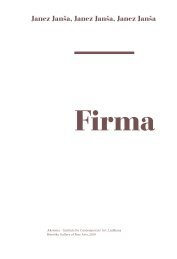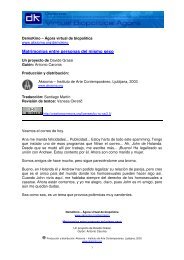You also want an ePaper? Increase the reach of your titles
YUMPU automatically turns print PDFs into web optimized ePapers that Google loves.
32 nega kulturnega prostora, sveta umetnosti, ponavljanja,artists Janez Janša, Janez Janša and Žiga Kariž. It does not 33izgube in prisvajanja pomenov, umetnostne zgodo-vine, identitete posameznika, birokracije, osebnega ...,se tokrat ustavi ob ključnem mediju likovne umetnosti innapetostih, ki jih ta ponuja danes.11 Igor Lukšič, “Politika”,Enciklopedija SlovenijeXV, Mladinska knjiga,Ljubljana 1995.manifest as an image of the political within an art project;rather, it is realised in the entirety of their opuses and publicactivities. The project of the twenty-seven paintings, orrather the nine triptychs, is not an image of the politicalin painting; it is an investigation of a possible network ofthe meanings of politics in fine arts.What is it that situates a painting within the field of thepolitical? One of the most important elements of fine arts –which places the painting within the framework of “guidingone’s activities in a certain direction, that is, towards therealisation of a certain goal” 11 – must be the signature of theauthor. As mentioned, there are two levels of signatures inthe painterly Janez Janša project. The image of the signatureis not political; like any other image, it is merely an imageof the political. The image within the painting is thus alsomerely an image of the real and not the real itself. However,the author’s signature – the signature of the painting – iswhat enters into the painting directly from the real and itis not merely an image. The signature is a socially agreedupon sign, which evaluates the painting within the paintingitself; it marks it, it attributes it and it ensures that thepainting, even before it leaves the studio to enter the social,acquires the possibility of its cultural and social evaluation.This is why the author’s signature is more political thanwhat is represented in the painting, for the latter is merelya motif, such as an image of a worker on strike, which initself is no more political than an image of a lonely monk onthe beach. While previously the Janez Janša project tackledquestions of Slovenian and international cultural space, artworld, the iteration, loss and assumption of meaning, arthistory, individual identity, bureaucracy, the personal, etc.,this time it confronts the key medium of fine arts and thetensions that the latter offers today.Translated by Polona Petek.




